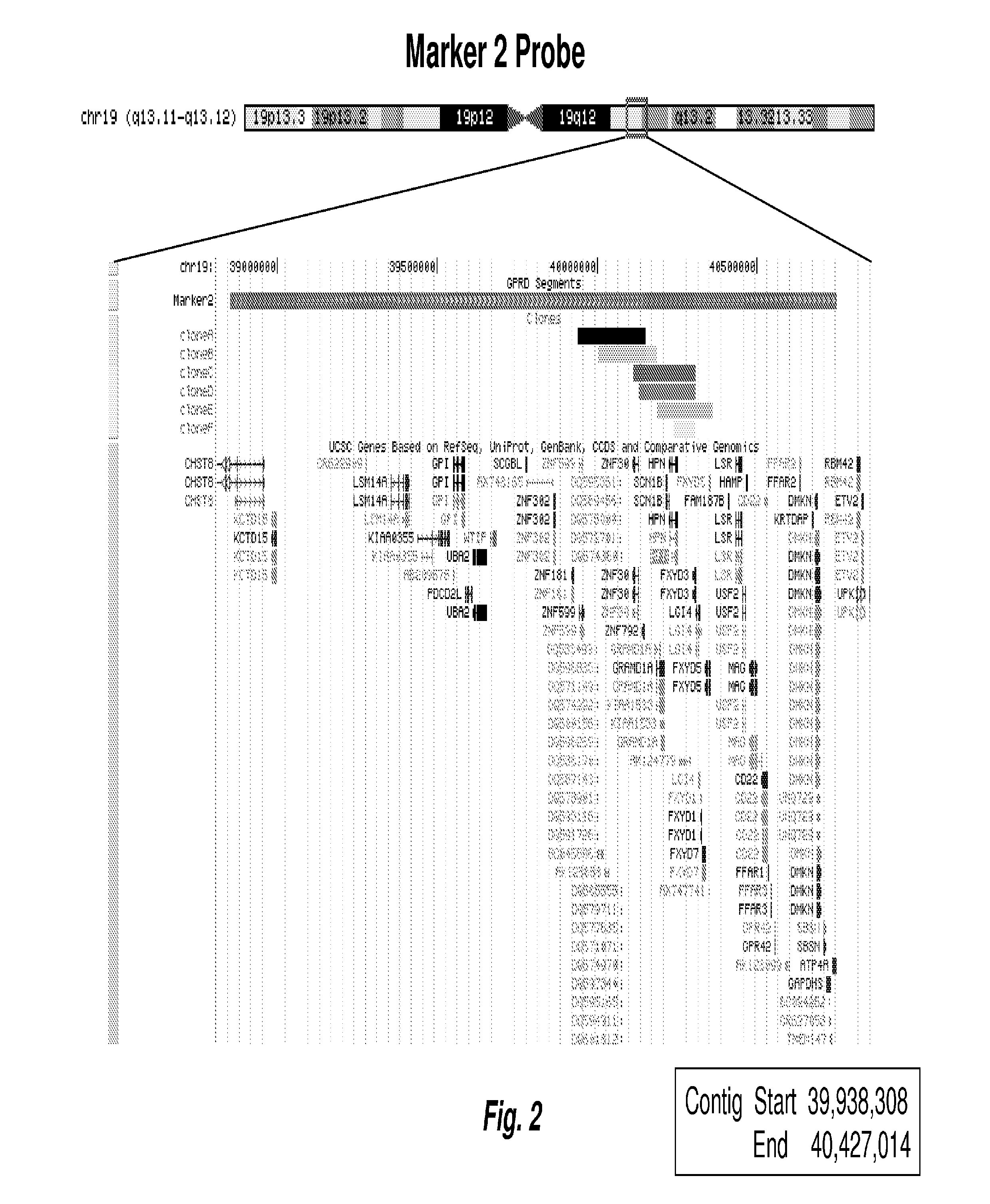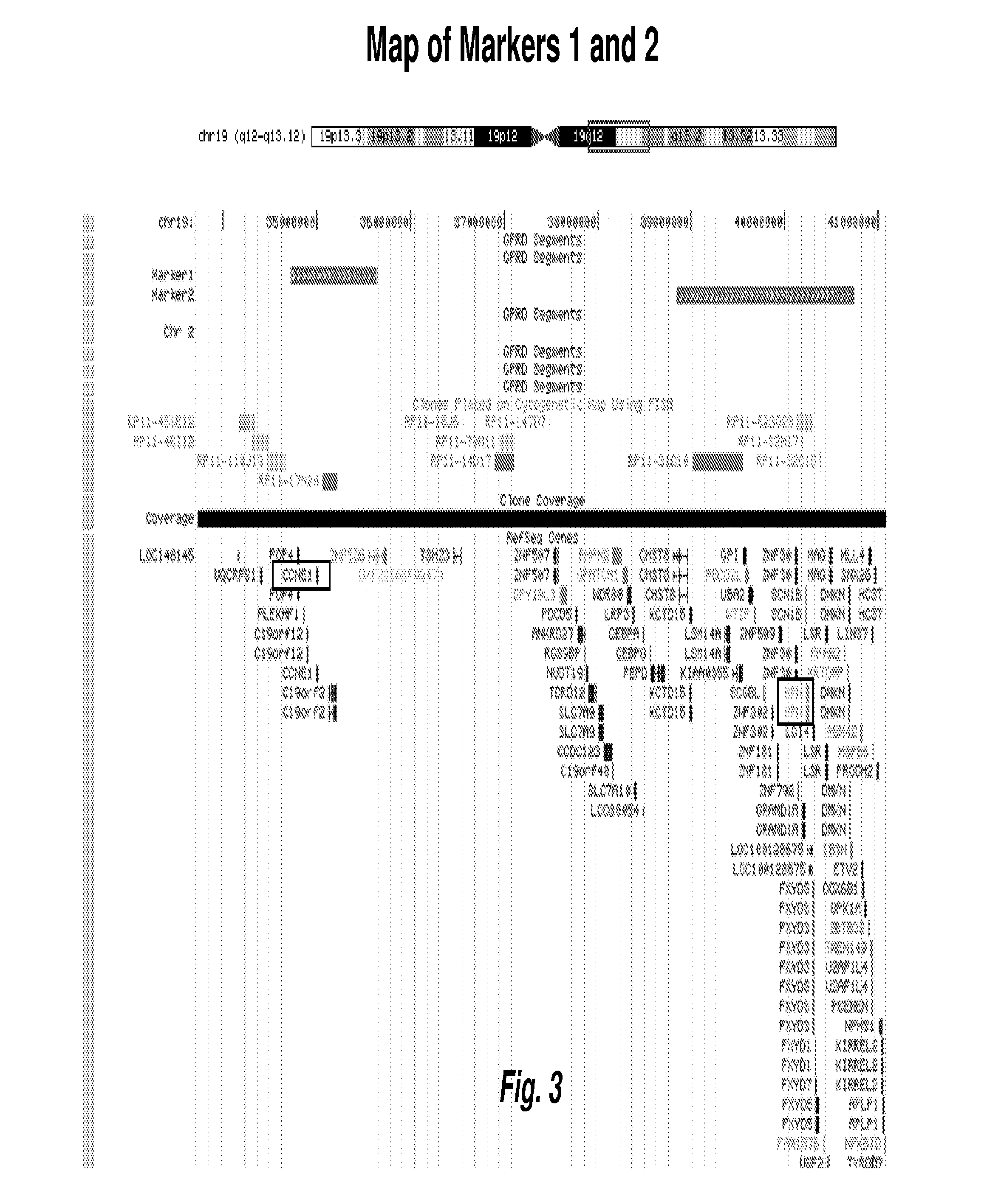Detection of chromosomal abnormalities associated with prognosis of non small cell lung cancer
a lung cancer and prognosis technology, applied in the field of in vitro diagnostic assays of lung cancer patients, can solve the problems of significant toxicities in patients who are treated, unacceptably high rate of patients developing, and the inability of diagnostic modalities to predict which patients will recur after surgery, etc., to achieve the effect of improving the survival rate of patients, improving the survival rate, and improving the survival ra
- Summary
- Abstract
- Description
- Claims
- Application Information
AI Technical Summary
Benefits of technology
Problems solved by technology
Method used
Image
Examples
example 1
Analysis of NSCLC Patient Samples
[0105]Experimental Methods: Specimens. A total of 178 NSCLC clinically annotated samples were profiled for copy number alterations using high-density SNP genotyping microarrays (100K array set by Affymetrix). All samples were carefully dissected to maximize tumor / normal tissue ratio and verify histopathological type and stage. Only samples from patients with stage I and II samples were analyzed. All of these were from patients treated with surgical resection without any follow-up or neoadjuvant chemotherapy. Clinical information collected for each patient included race, age, date of birth, sex, clinical stage, pathological stage, location, surgical procedure (SP) date, histology, differentiation, diagnosis date, node positivity, smoking status, chemotherapy status, radiation status, recurrence status, recurrence date, recurrence location, time to recurrence, date of last follow up, status at the last follow up, alive / dead, overall survival and cause ...
example 2
Validation of Prognostic Markers Using a Korean Sample Set
[0114]To validate forty-six (46) of the biomarkers that correlated with the clinical outcome of low stage NSCLC patients, an additional set of low stage NSCLC tumor tissues was collected from the Samsung Cancer Center in Korea, together with associated clinical outcome information.
[0115]All samples were carefully dissected to maximize tumor / normal tissue ratio and verify histopathological type and stage. Only samples from patients with stage I and II samples were analyzed. All of these were from patients treated with surgical resection without any follow-up or neoadjuvant chemotherapy. Clinical information collected for each patient included age, sex, clinical stage, pathological stage, location, histology, differentiation, smoking status, chemotherapy status, radiation status, recurrence status, recurrence date, recurrence location, brain metastasis status, time to recurrence, date of last follow up, status at the last follo...
example 3
FISH Probes To Chromosome Regions Associated with Increased Risk of Poor Disease Outcome in NSCLC
[0121]Following identification and validation of the biomarkers as described in Examples 1 and 2 above, FISH probes to the identified chromosome regions, i.e., 1p, 2q, 3q, 3q, 4p, 4q, 5q, 6p, 6q, 8p, 9p, 10q, 11q, 12p, 14q, 16q, 17q, and 19q, were made at Abbott Molecular using standard techniques, each probe targeting a chromosome region or subregion as identified herein. Table lists the targeted chromosomal regions by chromosome, start and end positions, start and end bands, and marker type (Amp=gain, Del=loss). FIGS. 1-6 are chromosomal maps of selected FISH probes. FIG. 1 shows the mapping of a FISH probe to “marker 1” on Chr19, at 19q12. FIG. 2 shows the mapping of a FISH probe to “marker 2” on Chr19, at 19g13.11-g13.12. FIG. 3 maps the two probes shown in FIGS. 1 and 2 together, on Chr19, at 19g12-13.12. FIG. 4 shows the mapping of two FISH contigs to “marker 5” on Chr12, at 12p13....
PUM
| Property | Measurement | Unit |
|---|---|---|
| Fraction | aaaaa | aaaaa |
| Fraction | aaaaa | aaaaa |
| Fraction | aaaaa | aaaaa |
Abstract
Description
Claims
Application Information
 Login to View More
Login to View More - R&D
- Intellectual Property
- Life Sciences
- Materials
- Tech Scout
- Unparalleled Data Quality
- Higher Quality Content
- 60% Fewer Hallucinations
Browse by: Latest US Patents, China's latest patents, Technical Efficacy Thesaurus, Application Domain, Technology Topic, Popular Technical Reports.
© 2025 PatSnap. All rights reserved.Legal|Privacy policy|Modern Slavery Act Transparency Statement|Sitemap|About US| Contact US: help@patsnap.com



